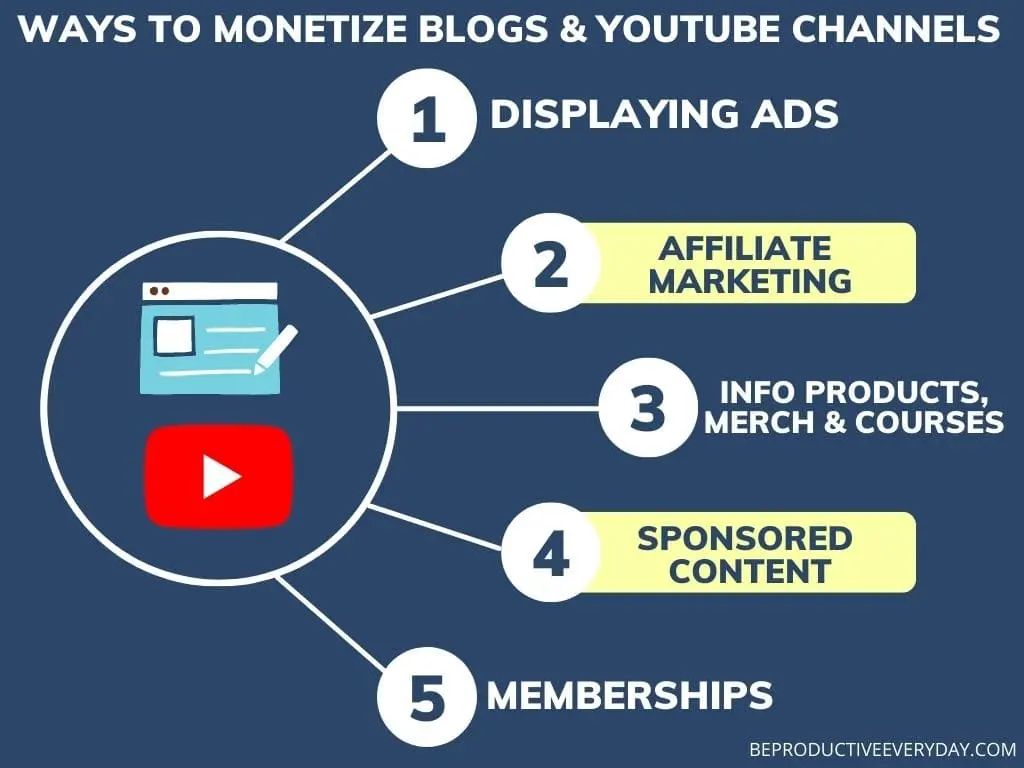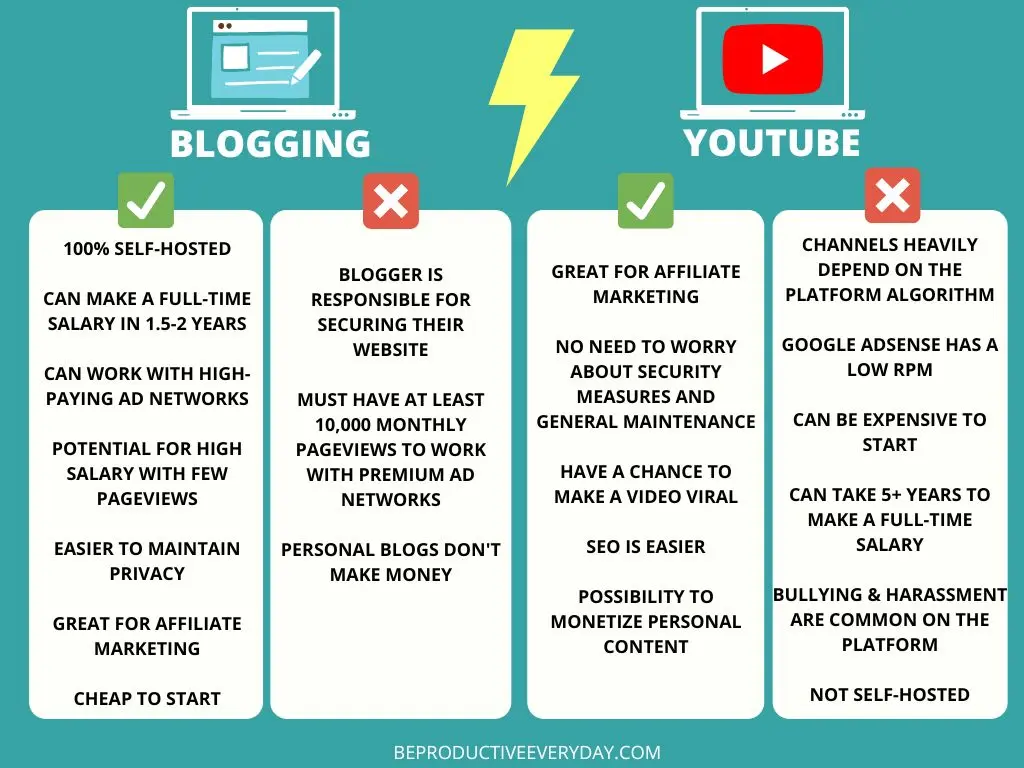If you’re trying to decide whether to launch a blog or start a YouTube channel — welcome to the classic “Which one pays better so I can quit my job faster?” dilemma.
Both work. Both can make real, delicious money.
Both can also make you want to scream into a pillow occasionally.
But the truth is: blogging and YouTube have very different income potential, timelines, costs, and personality fits. And 2026 looks nothing like 2018 or even 2022 — monetization strategies have changed dramatically.
So let’s cut the outdated advice, sprinkle some real-world data, and figure out:
- Which platform makes more money
- How long does each take to monetize
- The TRUE cost of starting each
- Whether introverts/extroverts do better on one
- And yes — which one you should pick
Let’s go.

🔹 What’s the Actual Difference Between a Blog and a YouTube Channel?
A blog is your little plot of digital land. You own the soil, the house, the front porch, the weird garden gnome — everything.
A YouTube channel is you renting a room in Google’s house. You can decorate it… but if Google wakes up with bad vibes one morning? They can change your wallpaper, rewrite your rules, and demonetize your life.
Both let you teach, entertain, help people, promote products, and make money online.
The big difference?
➡️ Blogs = text
➡️ YouTube = video
Simple. But the long-term consequences of that difference are huge. Let’s talk money.
🔹 So… Which One Makes More Money?

I’ll give you the honest, 2026-accurate answer:
→ Blogs monetize faster and give you more control.
→ YouTube has the potential for higher upside — but only if you’re consistent and not camera-shy.
But let’s break it down the fun way.
🎯 Blogging income potential (realistic)
A beginner blogger can hit:
- $500–$1,000/mo in 9–18 months
- $3,000–$7,000/mo in 18–36 months
- Much more if they later add digital products, courses, or high-ticket affiliate offers
Blogs shine because:
- You control your monetization
- Affiliate links convert incredibly well from Google search
- Ads pay higher RPMs than YouTube (you can partner with premium ad networks once you hit 10,000 monthly page views)
- Posts keep earning forever
🎯 YouTube income potential (realistic)
A beginner YouTuber can hit:
- $0–$200/mo for a long time (Ads are trash at first, and you’re limited to Adsense, which is famous for extremely low RPMs unless you’re in finance, insurance, or B2B niches)
- $1,000–$3,000/mo once affiliate marketing kicks in
- Much more if they eventually create digital products, courses, or get big sponsorships
Is viral success possible?
Yes.
Should you count on it?
Absolutely not. (Unless you enjoy heartbreak.)
🔹 Blogging vs YouTube RPM (Ad Earnings): The Real Numbers
Let’s clear up something that older blog posts get very, VERY wrong:
📌 Blogging Ad RPM (2026)
Requirements: You can join a premium ad network once you hit 10,000 pageviews per month.
Professional ad networks (i.e., Journey, Mediavine, Raptive) pay on average:
- $10–$30 per 1,000 pageviews
(Depending on niche, country, and buyer intent.)
📌 YouTube Ad RPM (2026)
Requirements: 1,000 subscribers along with either 4,000 valid public watch hours in the past year OR 10 million valid public Shorts views in the past 90 days.
Most creators earn (Adsense limits YouTube):
- $1–$3 per 1,000 views
- $5–$12 in business-related niches (finance, insurance, or B2B niches)
- Under $1 in entertainment niches (gaming, lifestyle, fashion, pop culture, gossip, travel)
➡️ Bloggers earn 3–10× more from ads per view than YouTubers.
Let that sink in.
🔹 Affiliate Marketing: The BIG Money Maker
Affiliate marketing is where both platforms actually shine.
Blogging → Affiliate Marketing is magic
Your audience finds you while searching for a specific problem.
This traffic converts like crazy.
Affiliate links blend naturally into:
- Buttons
- Product boxes
- Tables
- Callouts
- Within text
Blogs = affiliate paradise.
YouTube → Still good, but limited
Your only link options are:
- Video description
- One pinned comment
And many viewers simply… never open the description.
(I see you. I know you’re scrolling.)
However, charismatic creators who know how to sell verbally can out-earn bloggers here, since they have the possibility of getting their videos viral, resulting in millions of views.
🔹 Selling Digital Products, Services, or Courses
Blogs
Blogs are AMAZING for selling:
- Ebooks
- Templates
- Courses
- Coaching
- Services
Google search traffic = buyers.
High intent = high conversions.
YouTube
YouTube is AMAZING for:
- Courses
- Workshops
- Coaching
Why?
Because people trust you faster when they can see your face, hear your voice, and watch you teach.
➡️ If your future self wants to sell a course, YouTube gives you an advantage.
🔹 Sponsored Content
Fair and simple:
- Blogs can charge $100–$3,000 per post
- YouTube channels can charge $300–$10,000 per video
YouTubers sometimes make way more per sponsorship because a video takes more effort, and brands know it.
🔹 MEMBERSHIPS + COMMUNITY EARNINGS
YouTube makes it easy: built-in memberships — but YouTube keeps 30% of your earnings.
That’s why YouTubers usually rely on platforms like Patreon, which retains a bit less from your profits (usually 15%).
Blogs need plugins to include memberships, and some set up — but you keep 90% (only have to pay a fee for a payment processor).
🔹 Income Summary: Who Wins?
🥇 Fastest to monetize: Blogging
🥇 Most stable long-term: Blogging
🥇 Highest ad earnings: Blogging
🥇 Best for selling courses: YouTube
🥇 Highest sponsorship rates: YouTube
🥇 Highest possible earnings: Both are unlimited (depends on niche + personality + monetization strategy)
🔥 Blogging vs YouTube: How Long Does It Take to Make Money?
📝 Blogging timeline
Contrary to outdated info:
- New blogs often take 6–12 months to gain traction
- With 2 posts/week, you can hit 3,000–20,000 monthly views within 12–18 months
- You can earn $500–$2,000/mo with fewer than 10,000 monthly visitors using affiliate marketing
Blogs DO require consistency — but the payoff compounds.
📹 YouTube timeline
You need:
- 1,000 subscribers
- 4,000 watch hours
Most beginners hit this around:
- 12–18 months
- 100–200 videos uploaded
(Yes, really.)
Even after monetization, ad revenue is still low unless you’re in a high-ticket niche like money or business.
YouTube = slower to start, faster to grow once you “click” with viewers.
🔥 Startup Costs Comparison: Blogging vs YouTube
Let’s talk money because your wallet deserves honesty.
💰 Blogging Startup Costs (2026)
Low-budget, but with everything needed:
- Domain: $10/year
- Hosting: $36–$200/year (I always recommend DreamHost — it’s where I host all my blogs. They fix all my dramatic techy–SEO arcs within an hour once I email them, it’s inexpensive, and domain names are FREE on yearly plans.)
- Theme: $0–$80 (Kadence is life)
- Optional tools: $0–$100/mo depending on needs
Total: $36–$300 to start
💰 YouTube Startup Costs (2026)
You can technically start with your phone…
But if you want quality:
- Good phone or camera: $0–$600
- Microphone: $20–$120
- Lighting: $20–$120
- Editing software: $0–$30/mo
- Backdrop/props (optional): $0–$100
Total: $40–$900 to start
Blogging is unquestionably cheaper.
🔥 Blogging vs YouTube: Which Is Better for Introverts vs Extroverts?
🧘 Introverts → Blogging wins
Blogging is PERFECT for:
- People who hate being on camera
- People who like deep research
- People who communicate best in writing
- People who love systems, organization, SEO
- People who like to grow at a slower pace
Zero face time. Zero filming. Zero “I hate my voice on camera.”
🎤 Extroverts → YouTube wins
YouTube is PERFECT for:
- People who love talking
- People who express themselves better verbally
- High-energy educators
- People who want to build an audience quickly through personality
If your friend always says, “You’d be great on YouTube,” listen to them.
Of course, every rule has its weirdos exceptions like me, who’s an extrovert (ENTP), actually likes cameras and voice recording, but loves writing and being the ruler of her own land so much that my soul is totally sold to blogging lol.
🔥 What Should YOU Choose?
Here’s the 2026 TL;DR:

Choose Blogging if you want:
- Faster monetization
- Higher RPM
- Lower startup costs
- More stable income
- Evergreen content
- To sell digital products easily
- To “dress up” every day in your oversized, baggy metal t-shirt (optional, but I do recommend)
Choose YouTube if you want:
- Faster devoted (influencer market is insane on video media) audience growth
- Higher sponsorship income
- To build authority through your face + voice
- To sell higher-priced courses
- To be the personality, not just the teacher
Choose Both if you want the perfect system:
YouTube grows your audience fast,
Your blog converts that audience into $$$ long-term.
The combo is chef’s kiss for 2026.
→ Don’t miss the next step on your blogging journey:
Master Guide “How to Grow a Blog in 2026 With Traffic Strategies That Actually Work.”
FAQ: Blogging vs YouTube Profitability
Yes. Blogging is more profitable than ever because Google now rewards helpful, personal experience content instead of keyword-stuffed essays.
Absolutely — but consistency matters more than niche. Expect 12–18 months of steady uploads before real traction.
Blogging is easier and cheaper. YouTube requires equipment, editing, filming, and overcoming camera anxiety.
You can — but only if you start with one and layer on the other once you’re consistent.






